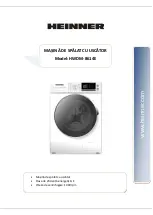
n
hers
oved
age 5)
ter
?
aundry
city.
er
nkles.
more
sh
dry
el
a
emove
to
y (wash
gram.
of
r
ng)
er?
2
dsing
T R O U B L E S H O O T I N G
17
will create a build up in the drying chamber and fan blower with lint
particles, reducing overall drying efficiency, and possibly damaging
your product (page 9).
Liquid detergents (Non-HE) are not recommended because
they produce too much foam, but if you prefer to use a liquid
detergent, do not use more than 1 tablespoon of HE liquid
detergent.
Common Laundry Problems
Your MALBER Washer/Dryer can safely wash and dry most items. Read and
follow fabric care label instructions for best results. Some common laundry
problems can be remedied easily using the suggestions that follow.
Note:
You are solely responsible for what you put into your MALBER
Washer/Dryer.
Graying or Yellowing
You may need slightly more detergent for heavily soiled or stained clothes
or if you have hard water.
Select the hottest temperature recommended for your fabric and wash load.
Pre-wash heavily soiled or stained items.
Reduce size of load so that wet clothes have room to tumble freely.
Be sure to use HE laundry detergent, not “soap.”
Install a water filter or use water conditioner weekly if water contains
excessive iron or manganese.
Lint or residue on clothes
Separate clothes that shed lint, such as terry cloth and chenille, from
clothes that attract lint, such as synthetics, corduroy, velveteen.
Use a low phosphate detergent to reduce residue that can appear to
be lint. Install a water softener if possible.
Use fabric softener only as directed, by adding to the softener
compartment of the dispenser drawer. Softeners mixed with detergents
in the wash cycle can leave a white residue (page 13).
To reduce piling, which can look like lint, turn cotton/polyester blend
fabrics inside out and use delicate cycle.
Excessive shrinkage / fabric damage
Follow garment care label instructions carefully. Make sure fabric is
washed and dried accordingly.
Some garments can be reshaped by ironing after washing and drying.
Fading and discoloration ...use appropriate wash programs
Wash in cool or cold water to retain dark or bright colors.
Separate dark items from light items. Dark clothes, especially cottons,
can bleed into wash water. White and light-colored clothes may absorb
these dyes.
Always empty pockets before washing.
Stains
Select Heavy Stain program for the appropriate fabric type (Normal or
Synthetics). Protein stains such as milk, egg, blood and soy should be
washed in cold water. Oily stains should be washed in the hottest water
safe for the fabric type.
Old stains may be hard to remove. Treat stains promptly and do not set
stains by drying or ironing fabrics until stains are completely removed.
Excessive wrinkling
Do not overfill machine. Wash synthetic fabrics items in half loads to
minimize wrinkling.
Use the correct wash program temperature setting for fabric type.
Synthetics press items in smaller loads. Do not mix with heavy items
such as towels or jeans.
Snags, tears, excessive wear
Empty all pockets and turn inside out before washing.
Fasten all hooks, snaps and zippers to avoid snags. Remove sharp
buckles.
Wash knits inside out.
Do not wash items soiled with harsh chemicals (hair care products,
cleaning solutions, etc.) with towels or other items that can be damaged
by the chemicals.
Mend items before laundering.
Wash synthetics press items in smaller loads. Do not mix with heavy
items such as towels or jeans.
Where’s the lint filter?
We refer to this feature as a coin-trap. Its conveniently located on
the lower right side of the front panel for easy access. This important
feature prevents any items (coins, pins, etc) left in your pockets from
damaging the drain pump. This coin-trap should be cleaned at least 4
times each year (more often with heavy family use).
Wash & Dry load examples.
With traditional washer and dryer products, the dryer tub is twice
the size of the washer to allow for the clothes to tumble freely. With
your MALBER combination washer / dryer product, you wash and dry
in the same tub (2.5 cu. ft). If you wash a full load (15lbs), you need
to remove half (7.5 lbs) of the fabric before starting a dry program.
When you select the combination mode (wash to dry automatically),
load the tub to accommodate this half load requirement.
Denim load 5 items (half-load)
2,5 HOURS DRY TIME
1 Blouse
1 Dress
3 Pair Blue Jeans
Bath towels 5 towels 48” x 29”
2 HOURS DRY TIME
Dry times will vary with load sizes, however these items are the
heaviest items to dry and are a good barometer.
Bedding 5 items
2 HOURS DRY TIME
1 King Fitted Sheet
2 King Pillow Cases
2 Perma Press shirts or blouses
(For best results wash and dry the flat and fitted sheets separately)
* load sizes are estimates. Your results might vary based on fabric type and load size.
Содержание WD 2000
Страница 1: ......
Страница 2: ...O S A V M C C Te In In Im A U Fa St G G O Pr C Us Us Tr Ta C Pr Se Impo from instr ...
Страница 20: ...SM2565 01 Stampa TLF 16 04 2008 461307521 ...


































